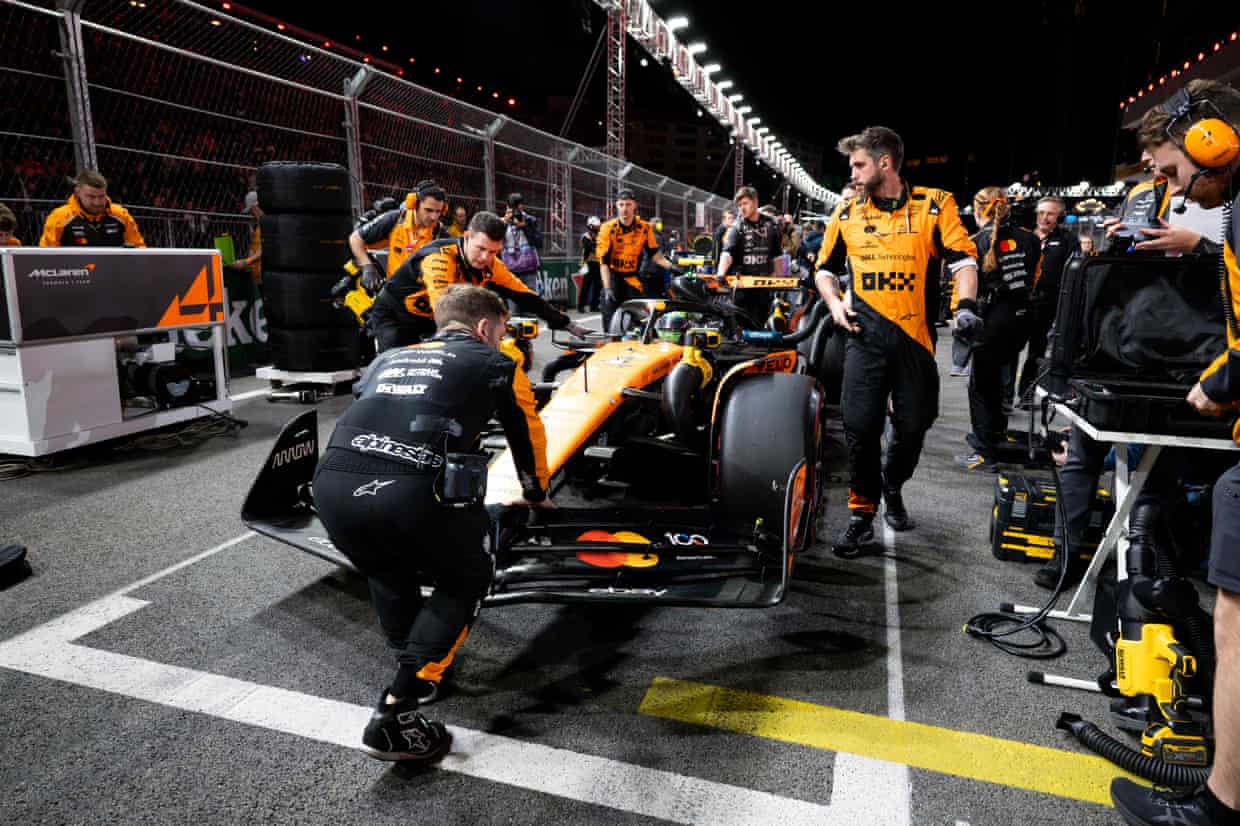How did McLaren get it so wrong with their cars in Las Vegas? | Giles Richards

As misjudgments go, McLaren’s error in calculations that led to the disqualification of Lando Norris and Oscar Piastri from the Las Vegas Grand Prix on Sunday could barely have been more cataclysmic nor more poorly timed,Quite how they got it wrong just when they wanted to close out the drivers’ championship with as little fuss as possible will take no little explanation,Norris and Piastri, second and fourth respectively to Max Verstappen’s win in Nevada, had been solid enough results until the FIA discovered the skid blocks on their cars had been worn beyond the 9mm limit,In one fell swoop, Verstappen was right back in the fight, alongside Piastri, 24 points back from Norris,It is exactly the sort of proximity to set nerves jangling unnecessarily with two meetings remaining and 58 points up for grabs.
Norris still holds the cards, but a single slip, an error, an unwanted contact, a mechanical failure or even another technical infringement and Verstappen could be breathing down his neck in an all or nothing season finale in Abu Dhabi.Such a prospect was unthinkable when he was 104 points behind Piastri after the Dutch GP on the final day of August.But for the miscalculation, Norris would have gone into the next round in Qatar with a 30-point lead over Piastri and 42 over Verstappen.There were, as McLaren argued, mitigating circumstances, albeit nothing that would change the decision.Teams want to run their cars as close to the ground as possible for aerodynamic efficiency and will push the limits.
How they set up their car for this depends on the type of circuit, its speed, its surface, whether it is bumpy and how the car subsequently behaves on it.This process of learning continues as the weekend goes on until the setup is finalised before qualifying.In Las Vegas, during second practice, vital time was lost to two stoppages and the usual race simulations were not completed, affecting information invaluable to setting up the ride height.The final practice session was wet, when cars behave aerodynamically differently to the dry, not least in not creating nearly as much downforce.Sign up to The RecapThe best of our sports journalism from the past seven days and a heads-up on the weekend’s actionafter newsletter promotionCome the race, the team were also unexpectedly experiencing the bouncing and bottoming of the car floor that has been a feature of the current ground-effect regulations.
All of this added up to excessive wear and a double disqualification.They were aware, it appears, of how close they were to the edge.Late in the race, Norris was instructed to adopt a lift‑and‑coast approach to his driving, ie coming off the throttle before the end of the straights.At the time it was assumed there was a need for saving fuel, but it seems it was to minimise wear to the skid block, which the team knew to be on the limit.Norris alluded to this in the statement McLaren issued, stating the race management in the final phase of the race was because of “issues on our car, which have unfortunately resulted in us being disqualified”.
All of which raises awkward questions as to why McLaren got it wrong when no other team who were in the same circumstances did.This is doubly the case, given they have such a strong car and were still in such a strong position in the drivers’ championship.Had it occurred early in the season, there would have been plenty of time to rectify it.The timing was terrible, with their need to push a margin of error far less urgent than, say, for Verstappen and Red Bull, given the Dutchman was trying to claw back a 49-point deficit.Norris can still close this out.
Outscoring both his rivals by two points in Doha, where 33 are on offer during the Saturday sprint race and Sunday grand prix, would seal it there,Quite how safe he and his team are feeling after this egregious fumble in Las Vegas is another question altogether,

Budget 2025: how inflation and the two-child benefit cap have increased poverty
“I’ve sat and cried many times, feeling like I’ve let my kids down,” is the heartbreaking description one Kent mother gives of the difficulty she has meeting her family’s needs.With four children still under 13, the family live in a rented flat in the town of Herne Bay on the county’s north coast. She does not come to the door, but her partner passes a handwritten note relaying their meagre existence on benefits as the Guardian joins the local food bank’s morning delivery round.“I have to be careful with electric and gas, and food has to be £1 frozen food,” she writes. “Snacks are a very rare treat

Bereaved parents face ‘harrowing’ delays for NHS postmorterms
Bereaved parents are enduring “harrowing” delays of more than a year to find out why their child died because the NHS has too few specialist doctors to perform postmortems.The shortage of paediatric and perinatal pathologists is revealed in a report by the Royal College of Pathologists published on Sunday. It warns that the situation is “dire”, services in some parts of the UK have “totally collapsed” and families are paying the price.The NHS has so few of those doctors that in some regions the bodies of babies and children who have died have to be taken elsewhere for examination, for example from Northern Ireland to Alder Hey children’s hospital in Liverpool, the college says.“Our service is in crisis”, said Dr Clair Evans, the chair of the college’s advisory committee that represents pathologists who specialise in the care of under-18s

‘We’ve got to find answers’: Corby families affected by cancer searching for truth about toxic waste sites
Alison Gaffney and Andy Hinde received the devastating news that their 17-month-old son, Fraser, had a rare type of leukaemia in 2018.Two years of gruelling treatment followed, including chemotherapy, radiotherapy and immunotherapy, before a stem cell transplant. Fraser, then aged three, made a “miraculous recovery” from the surgery, before doctors declared the cancer in remission.It was at this point, as Fraser started to recover and grow stronger, that Gaffney, 36, began to look for answers. She could not stop thinking about comments made by hospital staff at the time of her son’s diagnosis

UK gambling firms spent ‘astronomic’ £2bn on advertising last year
British gambling companies spent an “astronomic” £2bn on advertising and marketing last year, according to a new estimate that has intensified calls for the chancellor to increase taxes on the sector.Bookmakers, online casinos and slot machine companies spent the sum through a mixture of print and digital promotions, as well as affiliate programmes, where third parties are paid to steer gamblers towards particular operators in return for a fee.The figure, produced by the leading media insights group WARC, far outstrips the £1.2bn that the Treasury collected last year from online casino companies.Media industry sources said the total spent on gambling advertising is likely to be hundreds of millions of pounds higher because it is difficult to accurately measure the actual amount of digital marketing spend

South Africa declares gender-based violence a national disaster amid G20 protests
Hundreds of women gathered in cities across South Africa on Friday to protest against gender-based violence in the country before the G20 summit in Johannesburg this weekend.Demonstrators turned out in 15 locations – including Johannesburg, Pretoria, Cape Town and Durban – wearing black as a sign of “mourning and resistance”.They staged a peaceful 15-minute silent lie-down protest, symbolising the 15 lives lost daily to gender-based violence in the country.South Africa has one of the world’s highest femicide rates, with UN Women estimating that it is five times higher than the global average.Called the G20 Women’s Shutdown, it was organised by the NGO Women For Change, which urged women and LGBTQ+ communities to “refrain from all paid and unpaid work in workplaces, universities and homes, and to spend no money for the entire day to demonstrate the economic and social impact of their absence”

Coroners’ prevention of future deaths reports should be legally enforced | Letters
Thank you for your article on how coroners’ prevention of future deaths (PFD) reports are being routinely ignored (Coroners’ advice on maternal deaths in England and Wales routinely ignored, study finds, 19 November).Experience has shown us that a coroner’s PFD report is issued in response to serious systemic failings and a trust’s inaction to prevent future tragedies. Tolerating poor care and refusing to learn seem to be shared features of health scandals, including the treatment of people with learning disabilities, such as our own beloved daughter, Juliet Saunders, who died aged 25.She died because the local hospital made a misdiagnosis and discharged her unsafely. The harrowing experience of the inquest was softened for us by the coroner seeing that Juliet was dearly loved and happy

Bro boost: women say their LinkedIn traffic increases if they pretend to be men

Leading law firm cuts London back-office staff as it embraces AI

Elon Musk’s Grok AI tells users he is fitter than LeBron James and smarter than Leonardo da Vinci

Xania Monet’s music is the stuff of nightmares. Thankfully her AI ‘clankers’ will be limited to this cultural moment | Van Badham

French authorities investigate alleged Holocaust denial posts on Elon Musk’s Grok AI

‘We excel at every phase of AI’: Nvidia CEO quells Wall Street fears of AI bubble amid market selloff